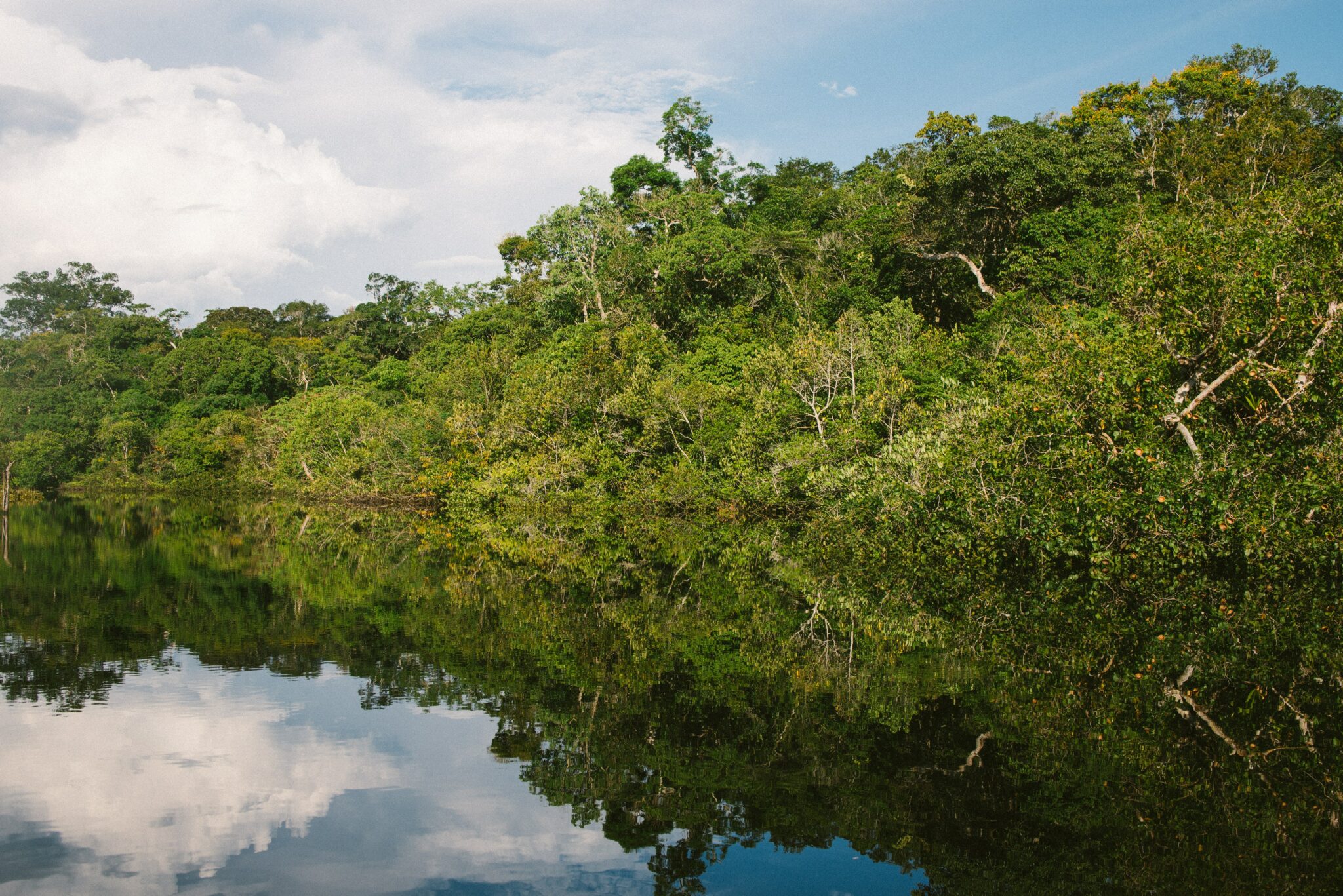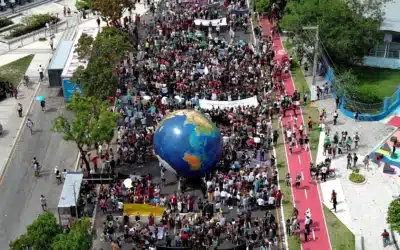Photo credit: Nathalia Segato
By: Diego Cardona – Censat Agua Viva and Global Forest Coalition
The fourth Amazon Summit has just taken place in Belém do Pará, Brazil, which brought together the presidents of member states of the Amazon Cooperation Treaty Organization (ACTO) and included a series of dialogues between a broad range of actors, including indigenous peoples, social movements, academics, NGOs, companies, corporations and financial entities.
Several results or proposals of this summit should be highlighted, as they may represent significant changes for the Amazon, its peoples and all other territories and populations that are connected to its dynamics, even beyond the borders of the jungle, which can in fact include any corner of the planet.
The Amazon Summit produced proposals for joint analysis and action regarding the region, which is to be materialized through a common vision among the states, allowing them to address common problems that transcend borders, such as deforestation and the trafficking of fauna, flora or drugs. To make most of the proposals viable, it is proposed that ACTO be strengthened. So far, it has played a discreet role without major impacts, but now there is a proposal to form a Regional Observatory on the Amazon (ORA) that would be responsible for monitoring and generating timely data in the areas of the economy, society, environment, and culture. This is a highly relevant action that is consistent with maintaining a broad and up-to-date view of realities of the region.
A multitude of social actors met as part of the Amazon dialogues held just before the summit, which, as is to be expected, exhibited diverse and in many cases diametrically opposed positions, proposals and discourses. Nevertheless, the dialogues were important in facilitating the encounter among diverse actors in the Amazon and identifying the stakes and proposals for the territory, with their opportunities and risks. Seen from the outside, the summit appeared to be a relevant moment for the coming together of Brazilian social movements, which, after a difficult period, are once again projecting themselves with strength. It is equally important that the summit welcomed and listened to the proposals of social processes and networks such as the Pan-Amazonian Social Forum (Fospa).
However, there is still a great deal of work to be done to achieve the goal of giving a “human face” to conservation and decision-making in the Amazon Basin, as the final declaration states. The text highlights the relevance of indigenous peoples and local and traditional Amazonian communities in matters related to their territory, but they did not have active and effective participation in the pre-summit and summit process. Evidence of this shortcoming was the protests in Belém by quilombola communities from the Brazilian Amazon, precisely because they felt that their presence and contributions were being ignored. This same lack of involvement was seen previously in Leticia, Amazonas, where there were big gaps in civil society representation of civil society, including broad sectors of local populations and peasants. Meanwhile, other social sectors had funding to travel to the host city of the pre-summit, and this meant there was a large presence of representatives of international cooperation, researchers or academics, conservation NGOs and the private sector.
Thus, in addition to the fact that the statement in the preamble of the declaration about giving “special attention to indigenous peoples and local and traditional communities in vulnerable situations” has not been fulfilled, other key Amazonian populations that are decisive in finding solutions to conflicts are also missing. This is the case of the peasantry, Afro-descendants and the urban poor, which are distributed across many cities, including Belém, and number more than two million inhabitants. Without these sectors, how can we dream of remedying deforestation and inequality, for example?
The participation of these long-excluded sectors must be active and effective, never simply for show, as happens in many matters, such as prior consultations in which the refusal of the populations to accept extractive projects has no effect. In Belém, the convention center that hosted the summit was the scene of demonstrations against oil exploitation in the Brazilian Amazon—and this was just a small sample of what millions of people in that country are demanding—however, no moratorium, ban or similar mechanism was included in the declaration. On the contrary, the 79th objective was a “dialogue between the Party STates on the sustainability of sectors such as mining and hydrocarbons in the region.” No mention was made of the Colombian government’s proposal to include a ban on oil exploitation in the Amazon basin.
This Brazilian position on so-called “responsible extractivism” in the Amazon is reminiscent of the unjustifiable argument of previous governments in Colombia, which in addition to promoting and deepening oil and mining in the jungle, ignored the impacts, looked the other way and focused on combating illegal activities such as unlicensed mining under the false notion that these are the only causes of the enormous socio-environmental conflict in the Amazon. It is troubling that this same optic is adopted in the Belém declaration, which ignores the impacts of oil exploitation, mining, and the construction of infrastructure such as highways and oil pipelines, as if the fact that they certain activities are legal exempts them from being root causes of territorial and ecological disputes.
The declaration also lacks a common goal to address deforestation and it is perhaps even more worrying that the document barely mentions forest degradation. It is hard to achieve an objective that is not mapped out or to find real, in-depth solutions to a problem whose existence is not recognized.
Forest degradation refers to the loss of the quality of forests, affecting their characteristics and reducing their capacity to carry out vital functions for themselves and for life on the planet, such as water and climate regulation or soil conservation. In many cases, such as Colombia, it is estimated that more land is affected by forest degradation each year than by deforestation. The Belém Declaration barely mentions this problem, only alluding to the participation of social actors in conservation efforts to reduce deforestation and degradation.
Finally, the insistence, both in Leticia and Belém, on the bioeconomy as a lifeline for the Amazon basin and its inhabitants is also worrying. The prefix “bio” can be used in different ways depending on one’s interests, and can mask actions such as biopiracy by pharmaceutical corporations or laboratories.
Likewise, the content of target 36 on debt-for-climate action swaps is disturbing at the very least. This may be due to the lack of depth in the explanation of what its purpose is and how it would work, or to the divergent positions on the subject between the Colombian President and Finance Minister. But in the face of lack of information and clarity, questions persist as to what is meant by climate action. Debt swaps are proposed to obtain resources, but resources to do what? What type of concrete actions would be carried out with them?
Other perspectives that should be considered include a view of borders beyond simply spaces for crime that should be taken up by leaders, such that they might understand them from the perspectives of Amazonian peoples for whom the drawing of lines with political divisions is a recent imposition an artificial separation of relatives and cultures. The urban environment in the middle of the largest jungle on the planet is another challenging issue. There is the challenge of defining what kind of cities we want to build and offer to its inhabitants, how to guarantee rights to people without sacrificing land, and how far to expand urban centers. These are just some of the issues to be resolved and, although the declaration includes a succinct objective, number 14, on Amazonian cities, it undoubtedly falls short in addressing the challenges.
It is therefore necessary to think and act beyond the logic of cooperation, which is the guiding principle of ACTO, and to consider an integrationist perspective. This implies transcending relationships based around the attainment of resources; exchanges between governments, agencies and institutions; and allowing for the rapprochement of Amazonian peoples and communities based on other types of values and priorities such as solidarity, equity and sovereignty.
This need was highlighted by Black women from French Guiana during the peoples’ assembly, which was held in parallel in Beleḿ. They called for recognition of the diversity of peoples in their territory, which is not part of ACTO, nor was it invited to the summit despite being part of the Pan-Amazonian region. Their voice is also a call to examine the relationships between our peoples, who determines them, whom we approach or who we distance ourselves from and why, and where we look to establish reference points.
Amazonian integration is essential.




